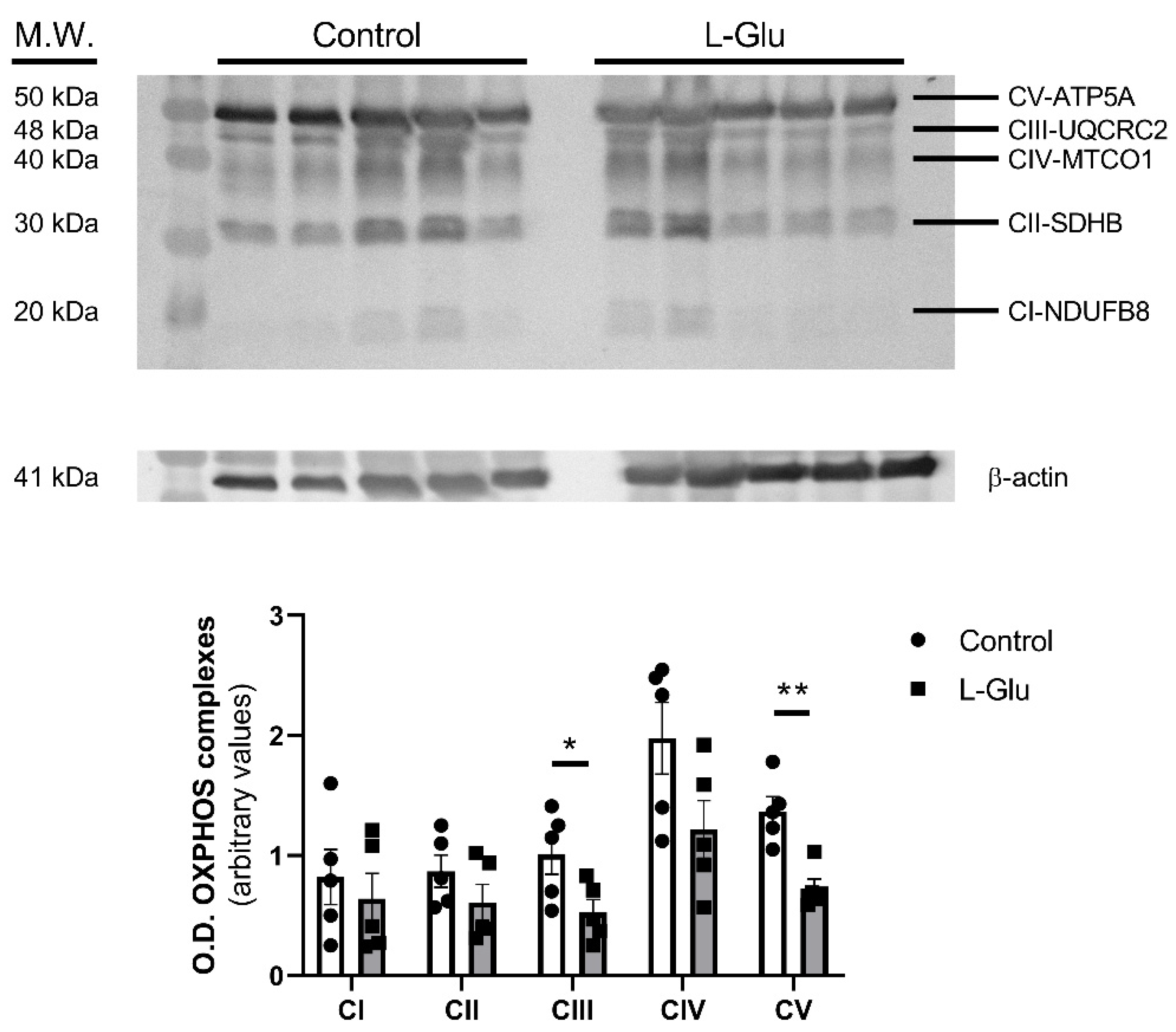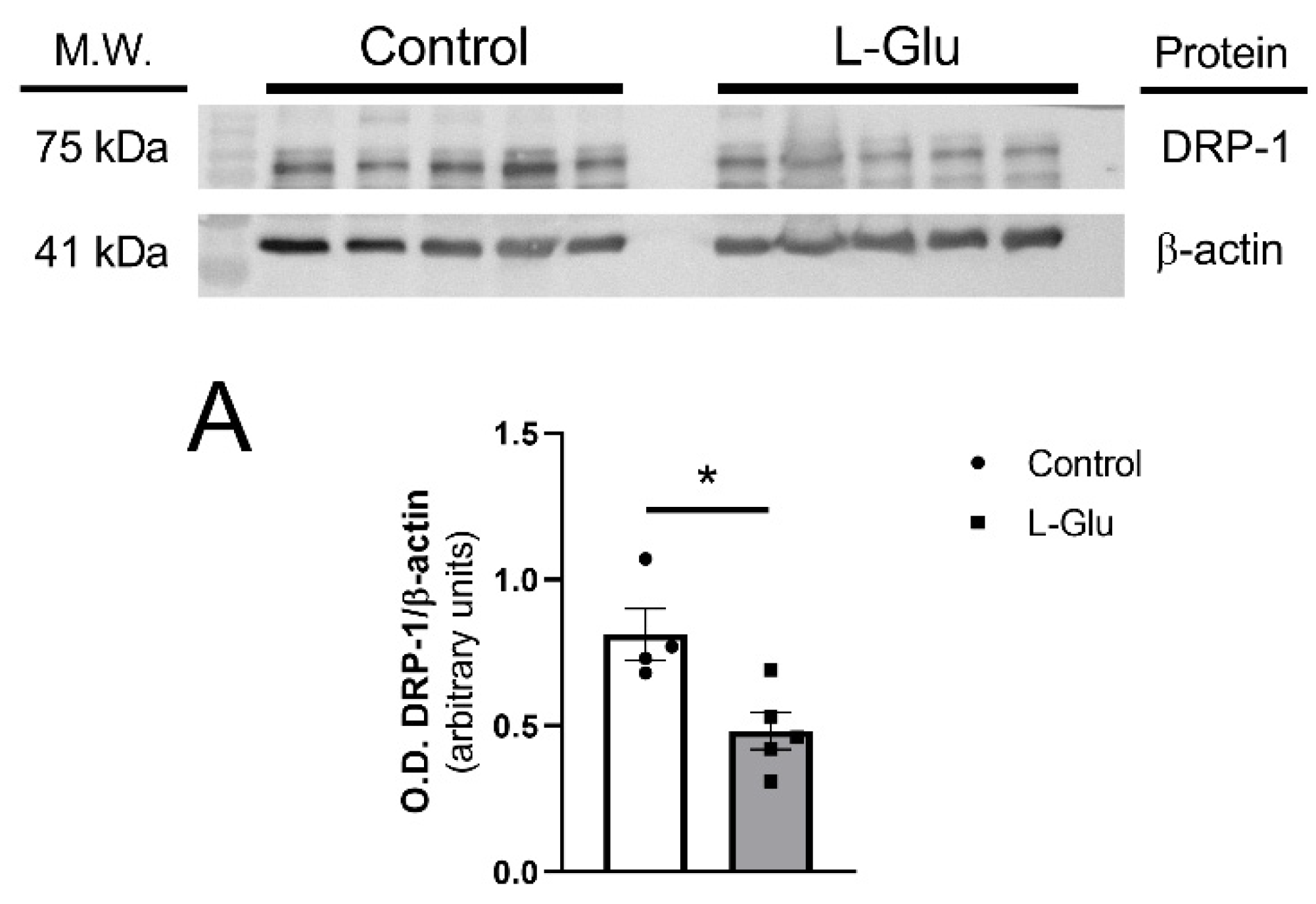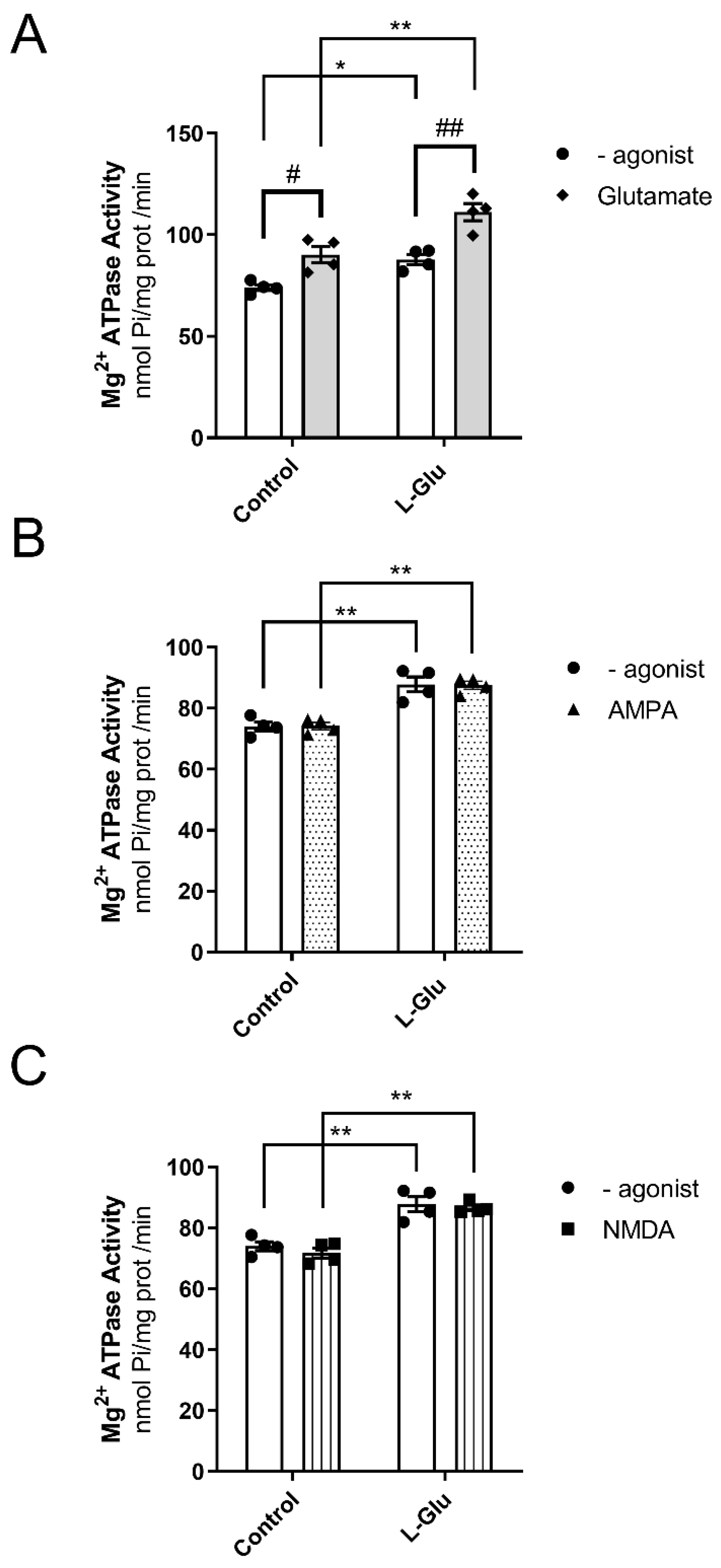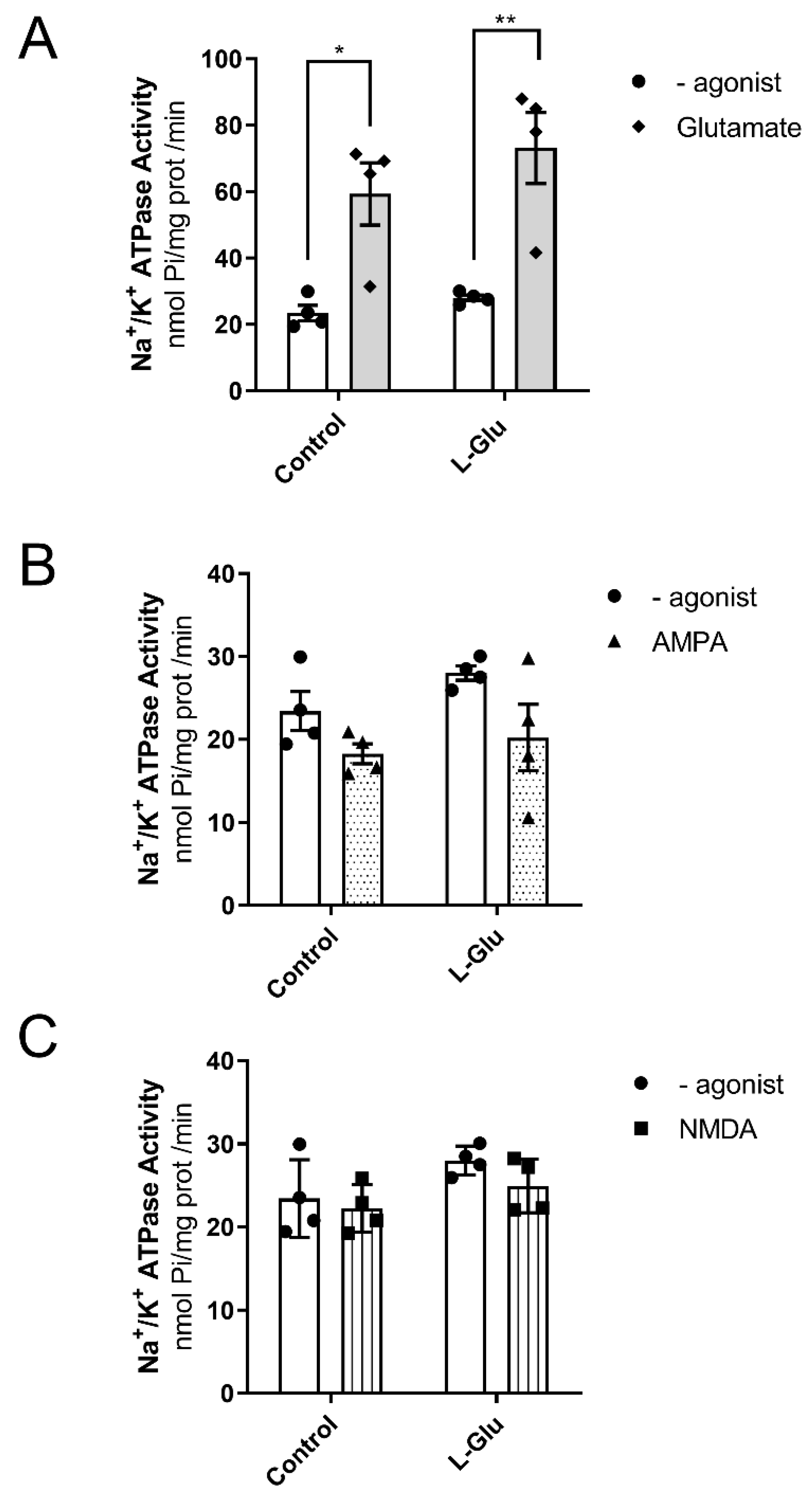Membrane ATPases and Mitochondrial Proteins in Fetal Cerebellum After Exposure to L-Glutamate During Gestation
Abstract
1. Introduction
2. Materials and Methods
2.1. Animal Treatment
2.2. Plasma Membrane Isolation
2.3. Immunoblotting Assay
2.4. Na+/K+-ATPase and Mg2+-ATPase Activities Assay
2.5. Statistical and Data Analysis
3. Results
3.1. Maternal Chronic L-Glu Intake During Gestation Alters the Mitochondrial Oxidative Phosphorylation Complex III and V in Fetal Cerebellum
3.2. Maternal Chronic L-Glu Intake During Gestation Alters the Levels of the Proteins Involved in the Dynamics of the Mitochondria in Fetal Cerebellum
3.3. Maternal Chronic L-Glu Intake During Gestation Alters the Activity of Mg2+-ATPase in Fetal Cerebellum
- (1)
- Is Mg2+-ATPase activity affected by maternal L-Glu consumption during gestation?
- (2)
- Can the activation of glutamate receptors modulate the activity of Mg2+-ATPase?
- (3)
- If the response to question two is positive, is this effect altered by the chronic gestational intake of L-Glu?
3.4. Maternal Chronic L-Glu Intake Did Not Alter the Activity of Na+/K+-ATPase in Fetal Cerebellum
4. Discussion
Limitations of the Study
Author Contributions
Funding
Institutional Review Board Statement
Data Availability Statement
Conflicts of Interest
References
- Blachier, F.; Boutry, C.; Bos, C.; Tomé, D. Metabolism and Functions of L-Glutamate in the Epithelial Cells of the Small and Large Intestines. Am. J. Clin. Nutr. 2009, 90, 814S–821S. [Google Scholar] [CrossRef] [PubMed]
- Koga, M.; Serritella, A.V.; Messmer, M.M.; Hayashi-Takagi, A.; Hester, L.D.; Snyder, S.H.; Sawa, A.; Sedlak, T.W. Glutathione Is a Physiologic Reservoir of Neuronal Glutamate. Biochem. Biophys. Res. Commun. 2011, 409, 596–602. [Google Scholar] [CrossRef] [PubMed]
- Meldrum, B.S. Glutamate as a Neurotransmitter in the Brain: Review of Physiology and Pathology. J. Nutr. 2000, 130, 1007S–1015S. [Google Scholar] [CrossRef] [PubMed]
- Niaz, K.; Zaplatic, E.; Spoor, J. Extensive Use of Monosodium Glutamate: A Threat to Public Health? EXCLI J. 2018, 17, 273–278. [Google Scholar] [CrossRef]
- Kayode, O.T.; Bello, J.A.; Oguntola, J.A.; Kayode, A.A.A.; Olukoya, D.K. The Interplay between Monosodium Glutamate (MSG) Consumption and Metabolic Disorders. Heliyon 2023, 9, e19675. [Google Scholar] [CrossRef]
- Onaolapo, A.Y.; Onaolapo, O.J. Dietary Glutamate and the Brain: In the Footprints of a Jekyll and Hyde Molecule. Neurotoxicology 2020, 80, 93–104. [Google Scholar] [CrossRef]
- Yamamoto, T.; Inui-Yamamoto, C. The Flavor-Enhancing Action of Glutamate and Its Mechanism Involving the Notion of Kokumi. npj Sci. Food 2023, 7, 3. [Google Scholar] [CrossRef]
- Jinap, S.; Hajeb, P. Glutamate. Its Applications in Food and Contribution to Health. Appetite 2010, 55, 1–10. [Google Scholar] [CrossRef]
- Zanfirescu, A.; Ungurianu, A.; Tsatsakis, A.M.; Nițulescu, G.M.; Kouretas, D.; Veskoukis, A.; Tsoukalas, D.; Engin, A.B.; Aschner, M.; Margină, D. A Review of the Alleged Health Hazards of Monosodium Glutamate. Compr. Rev. Food Sci. Food Saf. 2019, 18, 1111–1134. [Google Scholar] [CrossRef]
- Beyreuther, K.; Biesalski, H.K.; Fernstrom, J.D.; Grimm, P.; Hammes, W.P.; Heinemann, U.; Kempski, O.; Stehle, P.; Steinhart, H.; Walker, R. Consensus Meeting: Monosodium Glutamate—An Update. Eur. J. Clin. Nutr. 2007, 61, 304–313. [Google Scholar] [CrossRef]
- Tejero, A.; León-Navarro, D.A.; Martín, M. Effect of Chronic Maternal L-Glu Intake during Gestation and/or Lactation on Oxidative Stress Markers, AMPA Glu1 Receptor and Adenosine A1 Signalling Pathway from Foetal and Neonatal Cerebellum. Purinergic Signal 2024, 20, 181–192. [Google Scholar] [CrossRef] [PubMed]
- Gbadamosi, I.; Yawson, E.O.; Akesinro, J.; Adeleke, O.; Tokunbo, O.; Bamisi, O.; Ibrahim-Abdulkareem, R.; Awoniran, P.; Gbadamosi, R.; Lambe, E.; et al. Vitamin D Attenuates Monosodium Glutamate-Induced Behavioural Anomalies, Metabolic Dysregulation, Cholinergic Impairment, Oxidative Stress, and Astrogliosis in Rats. Neurotoxicology 2024, 103, 297–309. [Google Scholar] [CrossRef] [PubMed]
- Adebayo, O.L.; Agu, V.A.; Idowu, G.A.; Ezejiaku, B.C.; Atunnise, A.K. The Role of Vitamin C on ATPases Activities in Monosodium Glutamate-Induced Oxidative Stress in Rat Striatum and Cerebellum. Neurotox. Res. 2024, 42, 40. [Google Scholar] [CrossRef] [PubMed]
- Reeber, S.L.; Otis, T.S.; Sillitoe, R. V New Roles for the Cerebellum in Health and Disease. Front. Syst. Neurosci. 2013, 7, 83. [Google Scholar] [CrossRef]
- Wu, J.Q.; Kosten, T.R.; Zhang, X.Y. Free Radicals, Antioxidant Defense Systems, and Schizophrenia. Prog. Neuropsychopharmacol. Biol. Psychiatry 2013, 46, 200–206. [Google Scholar] [CrossRef]
- Kowalczyk, P.; Sulejczak, D.; Kleczkowska, P.; Bukowska-Ośko, I.; Kucia, M.; Popiel, M.; Wietrak, E.; Kramkowski, K.; Wrzosek, K.; Kaczyńska, K. Mitochondrial Oxidative Stress-A Causative Factor and Therapeutic Target in Many Diseases. Int. J. Mol. Sci. 2021, 22, 13384. [Google Scholar] [CrossRef]
- Checa, J.; Aran, J.M. Reactive Oxygen Species: Drivers of Physiological and Pathological Processes. J. Inflamm. Res. 2020, 13, 1057–1073. [Google Scholar] [CrossRef]
- Balog, J.; Mehta, S.L.; Vemuganti, R. Mitochondrial Fission and Fusion in Secondary Brain Damage after CNS Insults. J. Cereb. Blood Flow. Metab. 2016, 36, 2022–2033. [Google Scholar] [CrossRef]
- Zhou, H.; Toan, S. Pathological Roles of Mitochondrial Oxidative Stress and Mitochondrial Dynamics in Cardiac Microvascular Ischemia/Reperfusion Injury. Biomolecules 2020, 10, 85. [Google Scholar] [CrossRef]
- Tilokani, L.; Nagashima, S.; Paupe, V.; Prudent, J. Mitochondrial Dynamics: Overview of Molecular Mechanisms. Essays Biochem. 2018, 62, 341–360. [Google Scholar] [CrossRef]
- Boldyrev, A.A.; Bulygina, E.R. Na/K-ATPase and Oxidative Stress. Ann. N. Y Acad. Sci. 1997, 834, 666–668. [Google Scholar] [CrossRef] [PubMed]
- Komali, E.; Venkataramaiah, C.; Rajendra, W. Antiepileptic Potential of Bacopa Monnieri in the Rat Brain during PTZ-Induced Epilepsy with Reference to Cholinergic System and ATPases. J. Tradit. Complement. Med. 2021, 11, 137–143. [Google Scholar] [CrossRef] [PubMed]
- Zaidi, A. Plasma Membrane Ca-ATPases: Targets of Oxidative Stress in Brain Aging and Neurodegeneration. World J. Biol. Chem. 2010, 1, 271–280. [Google Scholar] [CrossRef] [PubMed]
- Kinoshita, P.F.; Leite, J.A.; Orellana, A.M.M.; Vasconcelos, A.R.; Quintas, L.E.M.; Kawamoto, E.M.; Scavone, C. The Influence of Na+, K+-ATPase on Glutamate Signaling in Neurodegenerative Diseases and Senescence. Front. Physiol. 2016, 7, 195. [Google Scholar] [CrossRef]
- Pierre, S.V.; Blanco, G. Na/K-ATPase Ion Transport and Receptor-Mediated Signaling Pathways. J. Membr. Biol. 2021, 254, 443–446. [Google Scholar] [CrossRef]
- Rose, E.M.; Koo, J.C.P.; Antflick, J.E.; Ahmed, S.M.; Angers, S.; Hampson, D.R. Glutamate Transporter Coupling to Na,K-ATPase. J. Neurosci. 2009, 29, 8143–8155. [Google Scholar] [CrossRef]
- Cholet, N.; Pellerin, L.; Magistretti, P.J.; Hamel, E. Similar Perisynaptic Glial Localization for the Na+,K+-ATPase Alpha 2 Subunit and the Glutamate Transporters GLAST and GLT-1 in the Rat Somatosensory Cortex. Cereb. Cortex 2002, 12, 515–525. [Google Scholar] [CrossRef]
- De Lores Arnaiz, G.R.; Bersier, M.G. Relationship between Na+, K+-ATPase and NMDA Receptor at Central Synapses. Curr. Protein Pept. Sci. 2014, 15, 761–777. [Google Scholar] [CrossRef]
- Zhang, D.; Hou, Q.; Wang, M.; Lin, A.; Jarzylo, L.; Navis, A.; Raissi, A.; Liu, F.; Man, H.-Y. Na,K-ATPase Activity Regulates AMPA Receptor Turnover through Proteasome-Mediated Proteolysis. J. Neurosci. 2009, 29, 4498–4511. [Google Scholar] [CrossRef]
- Nathanson, J.A.; Scavone, C.; Scanlon, C.; McKee, M. The Cellular Na+ Pump as a Site of Action for Carbon Monoxide and Glutamate: A Mechanism for Long-Term Modulation of Cellular Activity. Neuron 1995, 14, 781–794. [Google Scholar] [CrossRef]
- Scavone, C.; Munhoz, C.D.; Kawamoto, E.M.; Glezer, I.; de Lima, L.S.; Marcourakis, T.; Markus, R.P. Age-Related Changes in Cyclic GMP and PKG-Stimulated Cerebellar Na,K-ATPase Activity. Neurobiol. Aging 2005, 26, 907–916. [Google Scholar] [CrossRef] [PubMed]
- Szentmihályi, K.; Szilágyi, M.; Balla, J.; Ujhelyi, L.; Blázovics, A. In Vitro Antioxidant Activities of Magnesium Compounds Used in Food Industry. Acta Aliment. 2014, 43, 419–425. [Google Scholar] [CrossRef]
- De Freitas, R.M.; Feng, D.; Jordán, J. Neuropharmacological Effects of Lipoic Acid and Ubiquinone on δ-Aminolevulinic Dehydratase, Na+, K+-ATPase, and Mg2+-ATPase Activities in Rat Hippocampus after Pilocarpine-Induced Seizures. Fundam. Clin. Pharmacol. 2011, 25, 211–216. [Google Scholar] [CrossRef] [PubMed]
- Crespo, M.; León-Navarro, D.A.; Martín, M. Na+/K+- and Mg2+-ATPases and Their Interaction with AMPA, NMDA and D2 Dopamine Receptors in an Animal Model of Febrile Seizures. Int. J. Mol. Sci. 2022, 23, 14638. [Google Scholar] [CrossRef]
- Shagirtha, K.; Bashir, N.; MiltonPrabu, S. Neuroprotective Efficacy of Hesperetin against Cadmium Induced Oxidative Stress in the Brain of Rats. Toxicol. Ind. Health 2017, 33, 454–468. [Google Scholar] [CrossRef]
- Garoui, E.; Ben Amara, I.; Driss, D.; Elwej, A.; Chaabouni, S.E.; Boudawara, T.; Zeghal, N. Effects of Cobalt on Membrane ATPases, Oxidant, and Antioxidant Values in the Cerebrum and Cerebellum of Suckling Rats. Biol. Trace Elem. Res. 2013, 154, 387–395. [Google Scholar] [CrossRef]
- León Navarro, D.; Albasanz, J.L.; Iglesias, I.; Ruiz, M.A.; Martín, M. Effect of Chronic Glutamate Administration to Pregnant Rats during Gestation on Metabotropic Glutamate Receptors from Mothers and Full-Term Fetuses Brain. Amino Acids 2005, 28, 127–137. [Google Scholar] [CrossRef]
- He, K.; Du, S.; Xun, P.; Sharma, S.; Wang, H.; Zhai, F.; Popkin, B. Consumption of Monosodium Glutamate in Relation to Incidence of Overweight in Chinese Adults: China Health and Nutrition Survey (CHNS). Am. J. Clin. Nutr. 2011, 93, 1328–1336. [Google Scholar] [CrossRef]
- Crespo, M.; León-Navarro, D.A.; Martín, M. Cerebellar Oxidative Stress and Fine Motor Impairment in Adolescent Rats Exposed to Hyperthermia-Induced Seizures Is Prevented by Maternal Caffeine Intake during Gestation and Lactation. Eur. J. Pharmacol. 2018, 822, 186–198. [Google Scholar] [CrossRef]
- Chan, K.M.; Delfert, D.; Junger, K.D. A Direct Colorimetric Assay for Ca2+-Stimulated ATPase Activity. Anal. Biochem. 1986, 157, 375–380. [Google Scholar] [CrossRef]
- Wang, X.Q.; Xiao, A.Y.; Sheline, C.; Hyrc, K.; Yang, A.; Goldberg, M.P.; Choi, D.W.; Yu, S.P. Apoptotic Insults Impair Na+, K+-ATPase Activity as a Mechanism of Neuronal Death Mediated by Concurrent ATP Deficiency and Oxidant Stress. J. Cell Sci. 2003, 116, 2099–2110. [Google Scholar] [CrossRef] [PubMed]
- Mohammadi, H.; Shamshirian, A.; Eslami, S.; Shamshirian, D.; Ebrahimzadeh, M.A. Magnesium Sulfate Attenuates Lethality and Oxidative Damage Induced by Different Models of Hypoxia in Mice. Biomed. Res. Int. 2020, 2020, 2624734. [Google Scholar] [CrossRef] [PubMed]
- Maier, J.A.M.; Locatelli, L.; Fedele, G.; Cazzaniga, A.; Mazur, A. Magnesium and the Brain: A Focus on Neuroinflammation and Neurodegeneration. Int. J. Mol. Sci. 2022, 24, 223. [Google Scholar] [CrossRef] [PubMed]
- Hu, C.; Huang, Y.; Li, L. Drp1-Dependent Mitochondrial Fission Plays Critical Roles in Physiological and Pathological Progresses in Mammals. Int. J. Mol. Sci. 2017, 18, 144. [Google Scholar] [CrossRef]
- Wang, S.; Tan, J.; Miao, Y.; Zhang, Q. Mitochondrial Dynamics, Mitophagy, and Mitochondria-Endoplasmic Reticulum Contact Sites Crosstalk Under Hypoxia. Front. Cell Dev. Biol. 2022, 10, 848214. [Google Scholar] [CrossRef]
- Brooks, C.; Cho, S.-G.; Wang, C.-Y.; Yang, T.; Dong, Z. Fragmented Mitochondria Are Sensitized to Bax Insertion and Activation during Apoptosis. Am. J. Physiol. Cell Physiol. 2011, 300, C447–C455. [Google Scholar] [CrossRef]
- Reddy, P.H.; Reddy, T.P.; Manczak, M.; Calkins, M.J.; Shirendeb, U.; Mao, P. Dynamin-Related Protein 1 and Mitochondrial Fragmentation in Neurodegenerative Diseases. Brain Res. Rev. 2011, 67, 103–118. [Google Scholar] [CrossRef]
- Grohm, J.; Kim, S.-W.; Mamrak, U.; Tobaben, S.; Cassidy-Stone, A.; Nunnari, J.; Plesnila, N.; Culmsee, C. Inhibition of Drp1 Provides Neuroprotection in Vitro and in Vivo. Cell Death Differ. 2012, 19, 1446–1458. [Google Scholar] [CrossRef]
- Kumari, S.; Mehta, S.L.; Li, P.A. Glutamate Induces Mitochondrial Dynamic Imbalance and Autophagy Activation: Preventive Effects of Selenium. PLoS ONE 2012, 7, e39382. [Google Scholar] [CrossRef]
- Knott, A.B.; Perkins, G.; Schwarzenbacher, R.; Bossy-Wetzel, E. Mitochondrial Fragmentation in Neurodegeneration. Nat. Rev. Neurosci. 2008, 9, 505–518. [Google Scholar] [CrossRef]
- Manczak, M.; Sesaki, H.; Kageyama, Y.; Reddy, P.H. Dynamin-Related Protein 1 Heterozygote Knockout Mice Do Not Have Synaptic and Mitochondrial Deficiencies. Biochim. Biophys. Acta 2012, 1822, 862–874. [Google Scholar] [CrossRef] [PubMed]
- Kanazawa, T.; Zappaterra, M.D.; Hasegawa, A.; Wright, A.P.; Newman-Smith, E.D.; Buttle, K.F.; McDonald, K.; Mannella, C.A.; van der Bliek, A.M. The C. Elegans Opa1 Homologue EAT-3 Is Essential for Resistance to Free Radicals. PLoS Genet. 2008, 4, e1000022. [Google Scholar] [CrossRef] [PubMed]
- Chen, H.; McCaffery, J.M.; Chan, D.C. Mitochondrial Fusion Protects against Neurodegeneration in the Cerebellum. Cell 2007, 130, 548–562. [Google Scholar] [CrossRef] [PubMed]
- Fernandez-Vizarra, E.; Zeviani, M. Mitochondrial Disorders of the OXPHOS System. FEBS Lett. 2021, 595, 1062–1106. [Google Scholar] [CrossRef]
- Lenaz, G. Role of Mitochondria in Oxidative Stress and Ageing. Biochim. Biophys. Acta 1998, 1366, 53–67. [Google Scholar] [CrossRef]
- Petrushanko, I.; Bogdanov, N.; Bulygina, E.; Grenacher, B.; Leinsoo, T.; Boldyrev, A.; Gassmann, M.; Bogdanova, A. Na-K-ATPase in Rat Cerebellar Granule Cells Is Redox Sensitive. Am. J. Physiol. Regul. Integr. Comp. Physiol. 2006, 290, R916–R925. [Google Scholar] [CrossRef]
- Bogdanova, A.; Petrushanko, I.; Boldyrev, A.; Gassmann, M. Oxygen- and Redox-Induced Regulation of the Na/K ATPase. Curr. Enzym. Inhib. 2006, 2, 37–59. [Google Scholar] [CrossRef]
- Garthwaite, J.; Balázs, R. Supersensitivity to the Cyclic GMP Response to Glutamate during Cerebellar Maturation. Nature 1978, 275, 328–329. [Google Scholar] [CrossRef]
- Sibarov, D.A.; Bolshakov, A.E.; Abushik, P.A.; Krivoi, I.I.; Antonov, S.M. Na+,K+-ATPase Functionally Interacts with the Plasma Membrane Na+,Ca2+ Exchanger to Prevent Ca2+ Overload and Neuronal Apoptosis in Excitotoxic Stress. J. Pharmacol. Exp. Ther. 2012, 343, 596–607. [Google Scholar] [CrossRef]
- Gusarova, G.A.; Dada, L.A.; Kelly, A.M.; Brodie, C.; Witters, L.A.; Chandel, N.S.; Sznajder, J.I. Alpha1-AMP-Activated Protein Kinase Regulates Hypoxia-Induced Na,K-ATPase Endocytosis via Direct Phosphorylation of Protein Kinase C Zeta. Mol. Cell Biol. 2009, 29, 3455–3464. [Google Scholar] [CrossRef]
- Dada, L.A.; Chandel, N.S.; Ridge, K.M.; Pedemonte, C.; Bertorello, A.M.; Sznajder, J.I. Hypoxia-Induced Endocytosis of Na,K-ATPase in Alveolar Epithelial Cells Is Mediated by Mitochondrial Reactive Oxygen Species and PKC-Zeta. J. Clin. Investig. 2003, 111, 1057–1064. [Google Scholar] [CrossRef] [PubMed]
- De Lores Arnaiz, G.R.; Ordieres, M.G.L. Brain Na+, K+-ATPase Activity In Aging and Disease. Int. J. Biomed. Sci. 2014, 10, 85–102. [Google Scholar] [CrossRef] [PubMed]
- Wakabayashi, J.; Zhang, Z.; Wakabayashi, N.; Tamura, Y.; Fukaya, M.; Kensler, T.W.; Iijima, M.; Sesaki, H. The Dynamin-Related GTPase Drp1 Is Required for Embryonic and Brain Development in Mice. J. Cell Biol. 2009, 186, 805–816. [Google Scholar] [CrossRef]
- Prastiwi, D.; Djunaidi, A.; Partadiredja, G. High Dosage of Monosodium Glutamate Causes Deficits of the Motor Coordination and the Number of Cerebellar Purkinje Cells of Rats. Hum. Exp. Toxicol. 2015, 34, 1171–1179. [Google Scholar] [CrossRef] [PubMed]






Disclaimer/Publisher’s Note: The statements, opinions and data contained in all publications are solely those of the individual author(s) and contributor(s) and not of MDPI and/or the editor(s). MDPI and/or the editor(s) disclaim responsibility for any injury to people or property resulting from any ideas, methods, instructions or products referred to in the content. |
© 2025 by the authors. Licensee MDPI, Basel, Switzerland. This article is an open access article distributed under the terms and conditions of the Creative Commons Attribution (CC BY) license (https://creativecommons.org/licenses/by/4.0/).
Share and Cite
Tejero, A.; León-Navarro, D.A.; Martín, M. Membrane ATPases and Mitochondrial Proteins in Fetal Cerebellum After Exposure to L-Glutamate During Gestation. Membranes 2025, 15, 152. https://doi.org/10.3390/membranes15050152
Tejero A, León-Navarro DA, Martín M. Membrane ATPases and Mitochondrial Proteins in Fetal Cerebellum After Exposure to L-Glutamate During Gestation. Membranes. 2025; 15(5):152. https://doi.org/10.3390/membranes15050152
Chicago/Turabian StyleTejero, Adrián, David Agustín León-Navarro, and Mairena Martín. 2025. "Membrane ATPases and Mitochondrial Proteins in Fetal Cerebellum After Exposure to L-Glutamate During Gestation" Membranes 15, no. 5: 152. https://doi.org/10.3390/membranes15050152
APA StyleTejero, A., León-Navarro, D. A., & Martín, M. (2025). Membrane ATPases and Mitochondrial Proteins in Fetal Cerebellum After Exposure to L-Glutamate During Gestation. Membranes, 15(5), 152. https://doi.org/10.3390/membranes15050152






